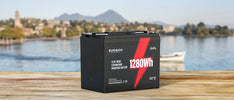
What Happens When Lithium Batteries Get Wet
, 4 min reading time


, 4 min reading time
Lithium batteries are essential in many modern electronic devices, providing efficient and reliable power storage. Understanding the impact of water exposure on these batteries is crucial to ensure their safe and optimal performance.
The general rule of thumb is to keep batteries in a cool and dry place. However, things happen and sometimes, your battery will get wet. So what happens after this happens, and is your battery completely dead?
When a lithium battery gets wet, the immediate effects can be severe. Water can cause short-circuiting by creating unintended conductive paths between the battery’s terminals. This can lead to sudden power loss and potential damage to the connected device. Additionally, exposure to water can cause the battery casing to leak, releasing potentially harmful substances.
Over time, continuous water exposure can lead to corrosion within the battery. This corrosion can damage internal components, significantly reducing the battery's performance and lifespan. A corroded battery is less efficient and more prone to failure, which can compromise the safety and functionality of electronic devices.
Different types of lithium batteries exhibit varying levels of water resistance. Lithium-ion (Li-ion) and Lithium-polymer (LiPo) batteries are some of the more common types, each with specific vulnerabilities. Li-ion batteries, widely used in consumer electronics, have a solid casing but are still susceptible to water damage. LiPo batteries, often found in high-performance applications like drones, are particularly vulnerable due to their flexible and less robust packaging.
Keeping batteries wet isn’t just about keeping their performance high: it’s about decreasing hazardous situations that occur when a battery gets wet.
One of the primary risks of wet lithium batteries is electrical hazards. Water exposure can cause short circuits, leading to potential fires or explosions. The risk of electrical malfunction increases significantly, posing a danger to both the user and the device.
Wet lithium batteries can also present chemical hazards. Water can cause the battery to leak toxic substances such as lithium salts and organic solvents. These chemicals can be harmful to humans and the environment if not handled properly.
Improper disposal of compromised lithium batteries can lead to environmental pollution. Toxic chemicals can leach into soil and water sources, causing long-term environmental damage. It’s crucial to dispose of damaged batteries in accordance with local regulations to minimize their environmental impact.
To protect lithium batteries from water damage, it is essential to store them correctly. Using waterproof containers and climate-controlled environments can help prevent moisture ingress. Proper storage conditions extend the battery’s lifespan and ensure safe usage.
When using lithium batteries, taking precautionary measures can significantly reduce the risk of water exposure. Sealing battery compartments and using protective casings can help shield the batteries from moisture. These measures are especially important in outdoor or humid environments.
All is not lost if your battery gets wet, however. There are steps you can take if it ever happens.
If your lithium battery gets wet, the first step is to turn off the device to prevent electrical hazards. Next, remove the battery from the device to minimize further damage and reduce the risk of short-circuiting.
Drying a wet lithium battery requires caution. Avoid direct heat sources such as hair dryers, which can damage the battery. Instead, use desiccants like silica gel packets to absorb moisture. Placing the battery in a sealed container with desiccants can help draw out the water more safely.
After drying, it is essential to check the battery for visible damage. Look for signs of corrosion, leakage, or swelling. Testing the battery’s performance in a controlled environment can help determine if it’s still usable or needs replacement.
Investing in water-resistant battery designs is a proactive way to prevent water damage. Many modern batteries come with enhanced seals and protective coatings. Proper handling during outdoor activities, such as using waterproof cases and avoiding exposure to rain or splashes, can also help protect your batteries. Regular maintenance and inspections ensure potential issues are identified and addressed early, preventing long-term damage.
By understanding the risks and taking preventive measures, you can ensure the longevity and safety of your lithium batteries. Proper care and handling are key to maintaining their performance and preventing hazardous situations.



